The Digital Transformation Spectrum: Connecting C-Suite to Command Line

In an era where digital transformation is more than just a buzzword, a chasm often exists between high-level strategic visions and on-the-ground technical implementation. This disconnect can lead to misaligned initiatives, inefficient resource allocation, and ultimately, failed transformation efforts. This guide aims to bridge that gap, providing a unified perspective that speaks to both strategists and technical specialists. By zooming in deep into the elements of cloud computing, data analytics, intelligent automation, and hybrid infrastructures, it provides a comprehensive overview of the entire digital transformation process.
From boardroom executives to technical teams on the front lines, this article serves as a common ground, promoting an understanding of both the challenges and prospects present in the current digital epoch. The complexity of today’s technology stacks — from containerized applications and Kubernetes clusters to multi-cloud environments and edge computing — demands a high level of coordination that can be daunting even for the most specialized teams.
By examining strategic imperatives alongside tangible tech deployments, we aim to forge a clear path that links overarching business goals with their technical implementations. Whether you are designing sweeping digital policies or deploying advanced technologies, this guide will offer essential insights to help you master the complexities of digital transformation.
Join us in unraveling the nuances of digital transformation, equipping both leaders and implementers with the knowledge they need to effect substantial change within their organizations.
Modern Infrastructures - Platforms for iPaaS, APIs, and Data
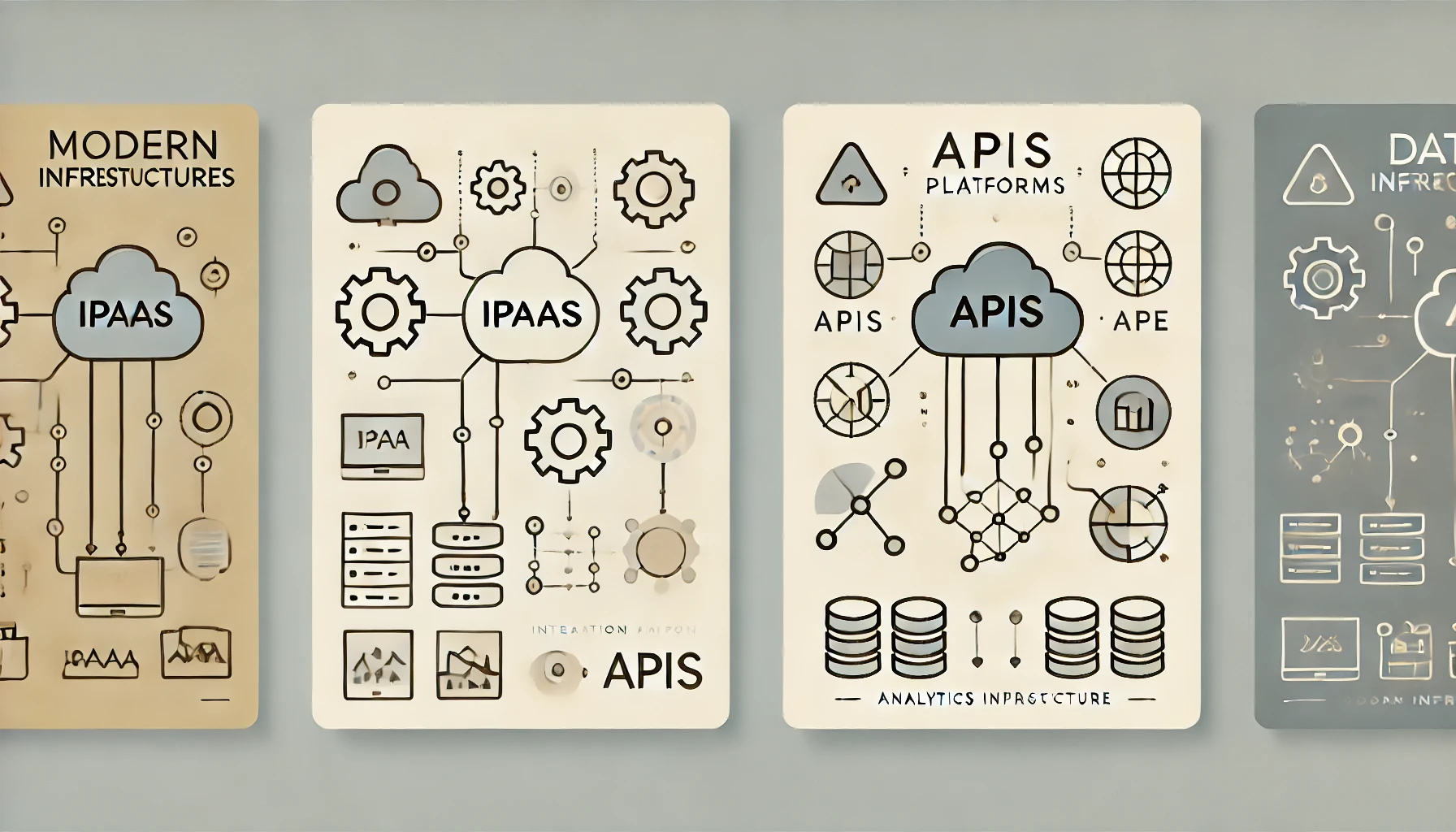
In 2024, AI and low-code/no-code (LAC/NC) platforms deliver smart, scalable, and easily provisionable integration and API management solutions. This chapter explores the integration of these technologies within AWS services, demonstrating how they support complex data flows and API management across different stages of data processing and business operations.
AWS AppFlow for Synchronous Data Integration
AWS AppFlow automates data flows between SaaS applications and AWS services, facilitating both real-time and batch data integration processes.
Example: Integrating Salesforce with Amazon S3 using AWS AppFlow:
aws appflow create-flow --flow-name "SalesforceToS3" \
--trigger-config TriggerType=OnDemand \
--source-flow-config SourceConnectorType=Salesforce,ConnectorProfileName="SF_Profile",SourceConnectorProperties='{"Object":"Account"}' \
--destination-flow-config DestinationConnectorType=S3,ConnectorProfileName="S3_Profile",DestinationConnectorProperties='{"BucketName":"my-s3-bucket","BucketPrefix":"sales-data/"}' \
--tasks 'TaskType=Filter,SourceFields=["Id","Name"],ConnectorOperator={"Salesforce":"PROJECTION"}'AWS DataSync for Initial Data Migration
AWS DataSync facilitates the initial migration of large datasets from on-premises storage to AWS solutions such as Amazon S3, streamlining the transition with minimal operational overhead.
Example: A command line to set up DataSync for initial migration from on-premises to S3 Bronze (landing) stage:
aws datasync create-task --source-location-arn <source-location-arn> \
--destination-location-arn <s3-bronze-arn> \
--name "OnPremToS3Bronze" \
--cloud-watch-log-group-arn <log-group-arn>Data Processing and Orchestration with AWS Glue and AWS Step Functions
AWS Glue prepares and transforms data for analytics, while AWS Step Functions orchestrate these workflows, managing transitions from initial raw data stages to more refined stages suitable for different types of analysis and reporting.
In modern data architectures, it's common to use a multi-stage approach often referred to as the Bronze, Silver, and Gold stages:
- Bronze Stage: This is the initial landing zone for raw data. Data in this stage is typically unprocessed and stored in its original format. It serves as a data lake for all incoming data, preserving the original information for auditing, reprocessing, or historical analysis.
- Silver Stage: In this intermediate stage, data undergoes initial processing and cleansing. This may include tasks such as data validation, deduplication, and basic transformations. The Silver stage provides a cleaner, more structured version of the data, suitable for some analytics and as a source for more complex transformations.
- Gold Stage: This is the final stage where data is fully processed and optimized for specific business needs. Gold data is typically aggregated, enriched, and formatted for easy consumption by end-users or business intelligence tools. It represents the highest quality, most valuable form of the data.
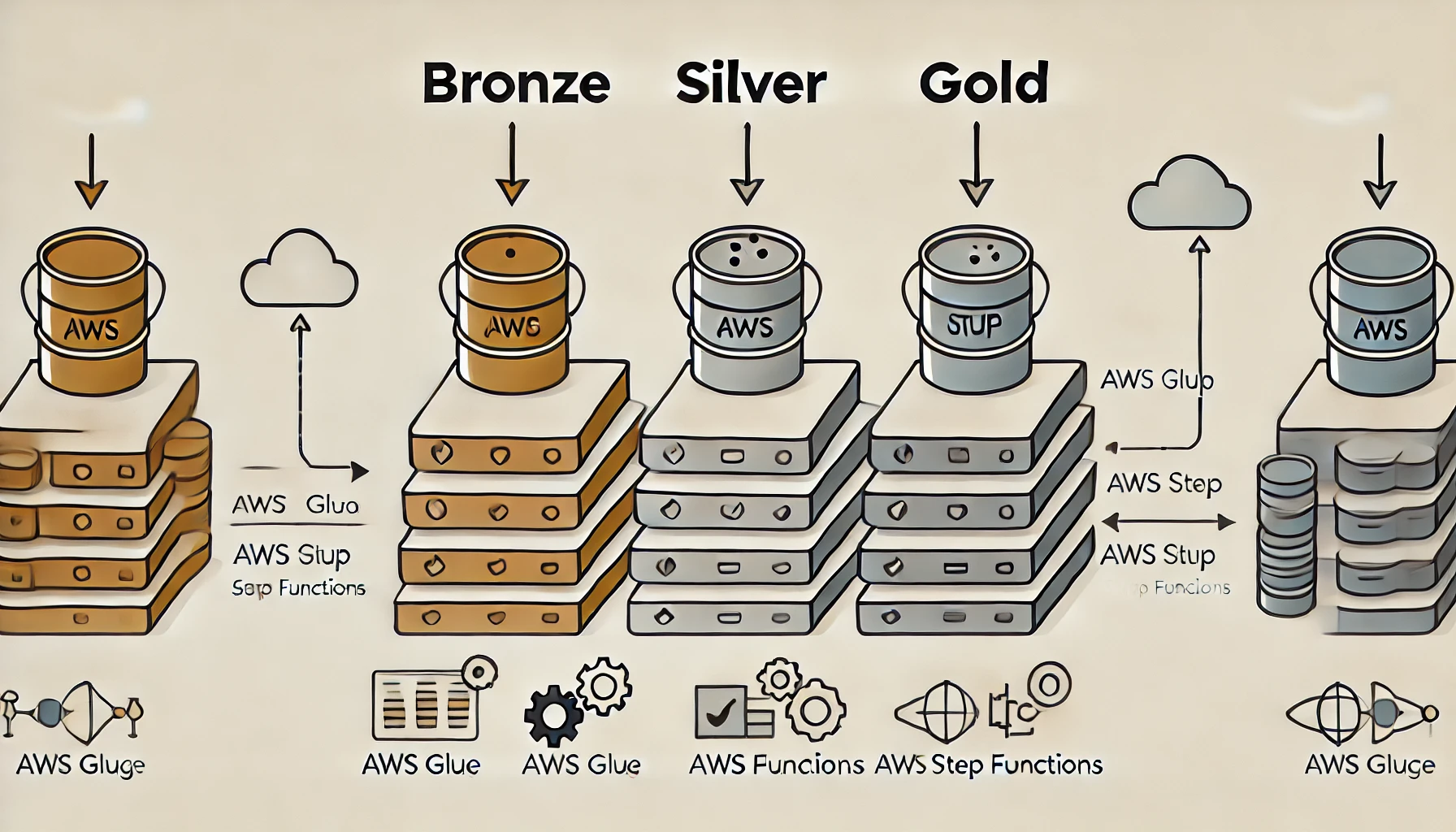
Example: Transitioning data from S3 Bronze to S3 Silver to S3 Gold using AWS Glue and Step Functions:
import boto3
import json
glue_client = boto3.client('glue')
sfn_client = boto3.client('stepfunctions')
# Start the Glue job to refine data from S3 Bronze to S3 Silver
glue_job_response = glue_client.start_job_run(JobName='BronzeToSilverGlueJob')
# Monitor and manage the Glue job workflow with Step Functions
step_input = {"JobRunId": glue_job_response['JobRunId']}
sfn_client.start_execution(
stateMachineArn='arn:aws:states:example:StateMachine:GlueJobFlow',
name='DataRefinementWorkflow',
input=json.dumps(step_input)
)Error Handling: Setting up S3 buckets to handle errors during data processing stages:
aws s3api create-bucket --bucket my-error-bucket --region us-west-2
aws s3api put-bucket-policy --bucket my-error-bucket --policy file://error-handling-policy.json. . .
This chapter provides a foundational understanding of how modern infrastructures leverage iPaaS, APIs, Data, and LC/NC technologies within AWS to enhance data management and integration capabilities. By seamlessly integrating these technologies, businesses can streamline operations and adapt more effectively to changing market demands.
AI Infrastructure Stack - AI to SaaS, Data, Legacy Assets
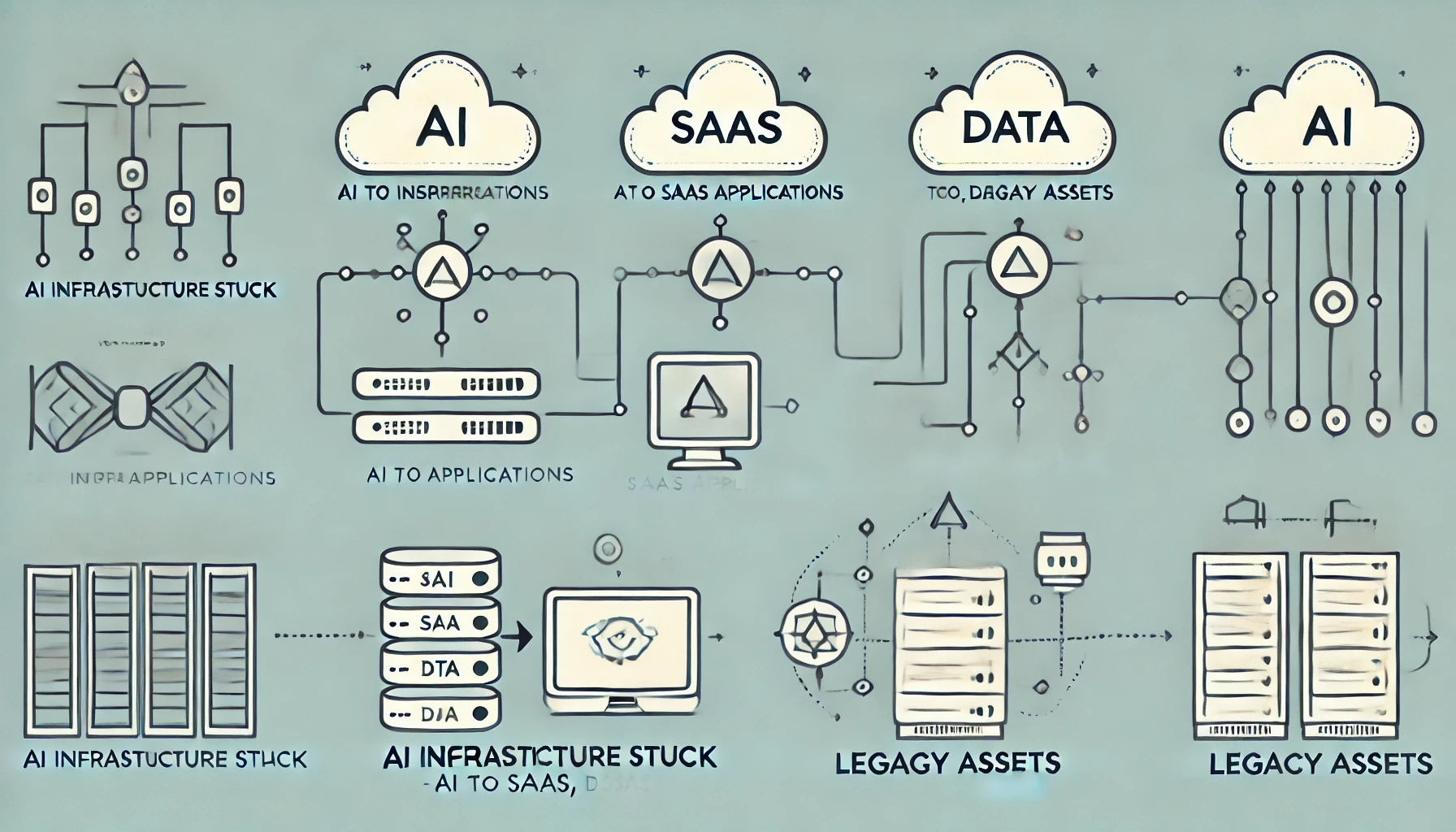
In today's digital economy, integrating AI across business processes can significantly enhance operations, yet it requires a robust understanding of the underlying infrastructure. This chapter delves into building the AI infrastructure stack using AWS services, detailing the integration of AI with SaaS applications, data management, and leveraging of legacy assets. It includes AWS CLI commands and Python code snippets to effectively demonstrate setups and integrations.
1. Setting Up AI Services on AWS
AWS offers a comprehensive suite of AI services that enable businesses to integrate advanced machine learning models without deep expertise.
Example: Command lines for deploying an Amazon SageMaker model for real-time predictions:
# Create a model
aws sagemaker create-model --model-name "my-model" \
--primary-container Image="382416733822.dkr.ecr.us-west-2.amazonaws.com/linear-learner:latest", ModelDataUrl="s3://my-model-bucket/model.tar.gz"
# Create an endpoint configuration
aws sagemaker create-endpoint-config --endpoint-config-name "my-model-config" \
--production-variants VariantName=AllTraffic,ModelName=my-model,InitialInstanceCount=1,InstanceType=ml.m5.large
# Create an endpoint
aws sagemaker create-endpoint --endpoint-name "my-realtime-endpoint" \
--endpoint-config-name "my-model-config"Example: A command line to configure Auto Scaling:
# Set up Auto Scaling for a SageMaker endpoint
aws application-autoscaling register-scalable-target --service-namespace sagemaker \
--resource-id endpoint/my-realtime-endpoint/variant/AllTraffic --scalable-dimension sagemaker:variant:DesiredInstanceCount \
--min-capacity 1 --max-capacity 52. Integrating AI with SaaS Applications
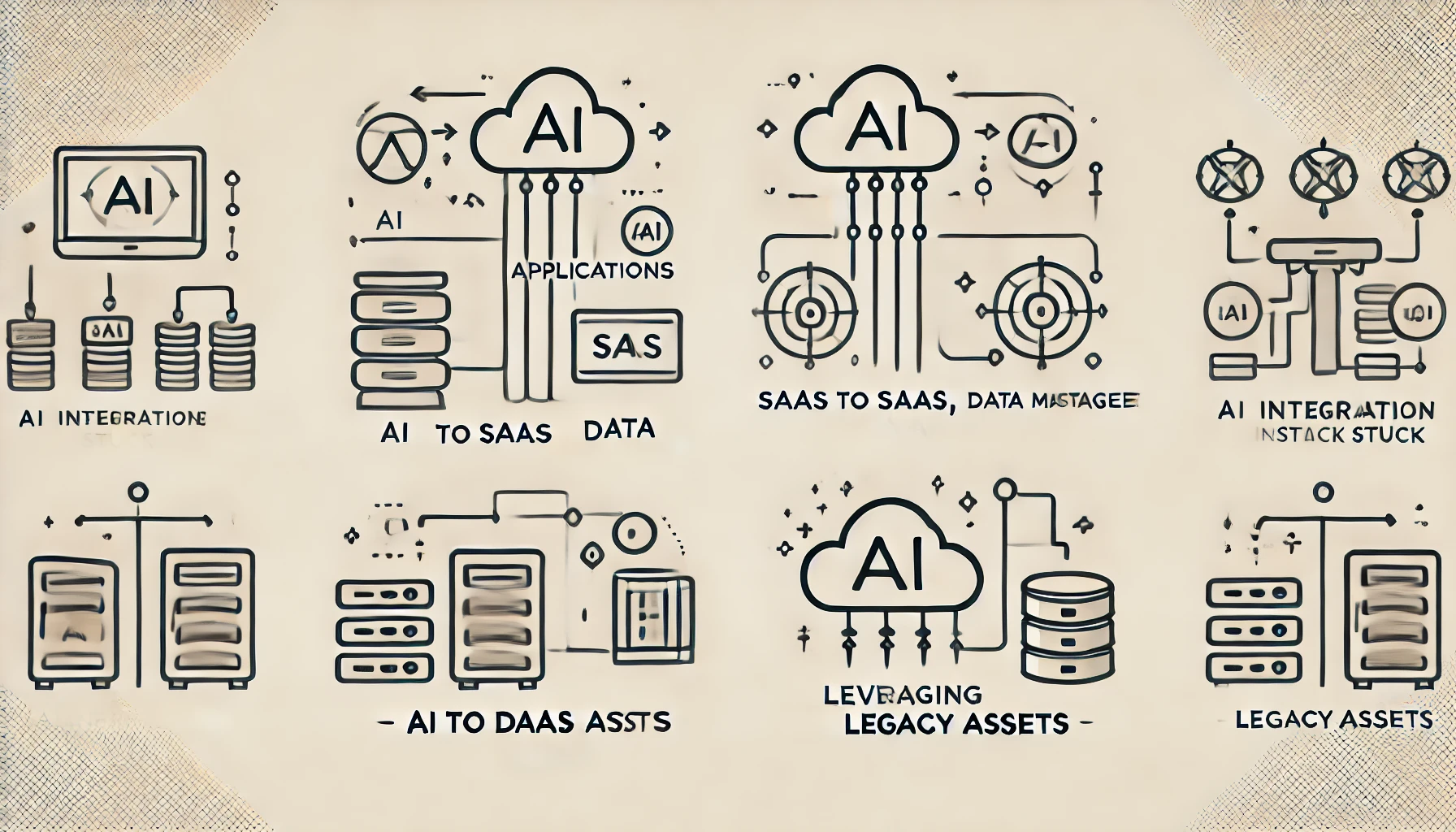
AWS enables seamless integration of AI capabilities with SaaS applications, enhancing functionality with AI-driven insights.
Example: Using AWS Lambda to integrate AI with a SaaS application:
import boto3
import json
import logging
from botocore.exceptions import ClientError
logger = logging.getLogger()
logger.setLevel(logging.INFO)
def lambda_handler(event, context):
client = boto3.client('comprehend')
try:
if 'text' not in event:
raise ValueError("'text' field is required in the event payload")
text = event['text']
response = client.detect_sentiment(Text=text, LanguageCode='en')
logger.info(f"Sentiment analysis completed for text: {text[:50]}...")
return {
'statusCode': 200,
'body': json.dumps({
'Sentiment': response['Sentiment'],
'SentimentScore': response['SentimentScore']
})
}
except ValueError as ve:
logger.error(f"ValueError: {str(ve)}")
return {
'statusCode': 400,
'body': json.dumps({'error': str(ve)})
}
except ClientError as e:
logger.error(f"AWS ClientError: {e.response['Error']['Message']}")
return {
'statusCode': 500,
'body': json.dumps({'error': 'Internal Server Error'})
}
except Exception as e:
logger.error(f"Unexpected error: {str(e)}")
return {
'statusCode': 500,
'body': json.dumps({'error': 'Internal Server Error'})
}3. Leveraging Legacy Assets in the AI Infrastructure
Many organizations have substantial investments in legacy systems. AWS offers various options to integrate these assets with modern AI solutions, ensuring that valuable historical data and processes can be incorporated into new AI-driven workflows.
Example: Using Amazon RDS to leverage legacy databases:
# Create a PostgreSQL database instance
aws rds create-db-instance --db-instance-identifier MyLegacyDB \
--db-instance-class db.t3.medium --engine postgres --allocated-storage 20 \
--master-username admin --master-user-password secret123 \
--backup-retention-period 7 \
--multi-az \
--storage-encrypted \
--enable-performance-insights
# Create a read replica for analytics workloads
aws rds create-db-instance-read-replica --db-instance-identifier MyLegacyDB-ReadReplica \
--source-db-instance-identifier MyLegacyDBimport boto3
import psycopg2
from psycopg2.extras import RealDictCursor
def query_legacy_data():
rds_client = boto3.client('rds')
try:
response = rds_client.describe_db_instances(DBInstanceIdentifier='MyLegacyDB-ReadReplica')
endpoint = response['DBInstances'][0]['Endpoint']['Address']
conn = psycopg2.connect(
host=endpoint,
database="mydatabase",
user="admin",
password="secret123"
)
with conn.cursor(cursor_factory=RealDictCursor) as cur:
cur.execute("SELECT * FROM legacy_table WHERE date > '2020-01-01'")
legacy_data = cur.fetchall()
return legacy_data
except Exception as e:
print(f"Error querying legacy data: {str(e)}")
return None
finally:
if conn:
conn.close(). . .
This chapter outlines how AWS can be leveraged to build an effective AI infrastructure stack, integrating AI with SaaS, managing data, utilizing legacy assets, and ensuring secure and scalable deployments. The examples provided serve as a glimpse into what is possible to achieve with a few command lines guide for organizations looking to enhance their capabilities in the AI-driven digital realm.
Data Platforms - Simplify Data, AI, Kubernetes & More
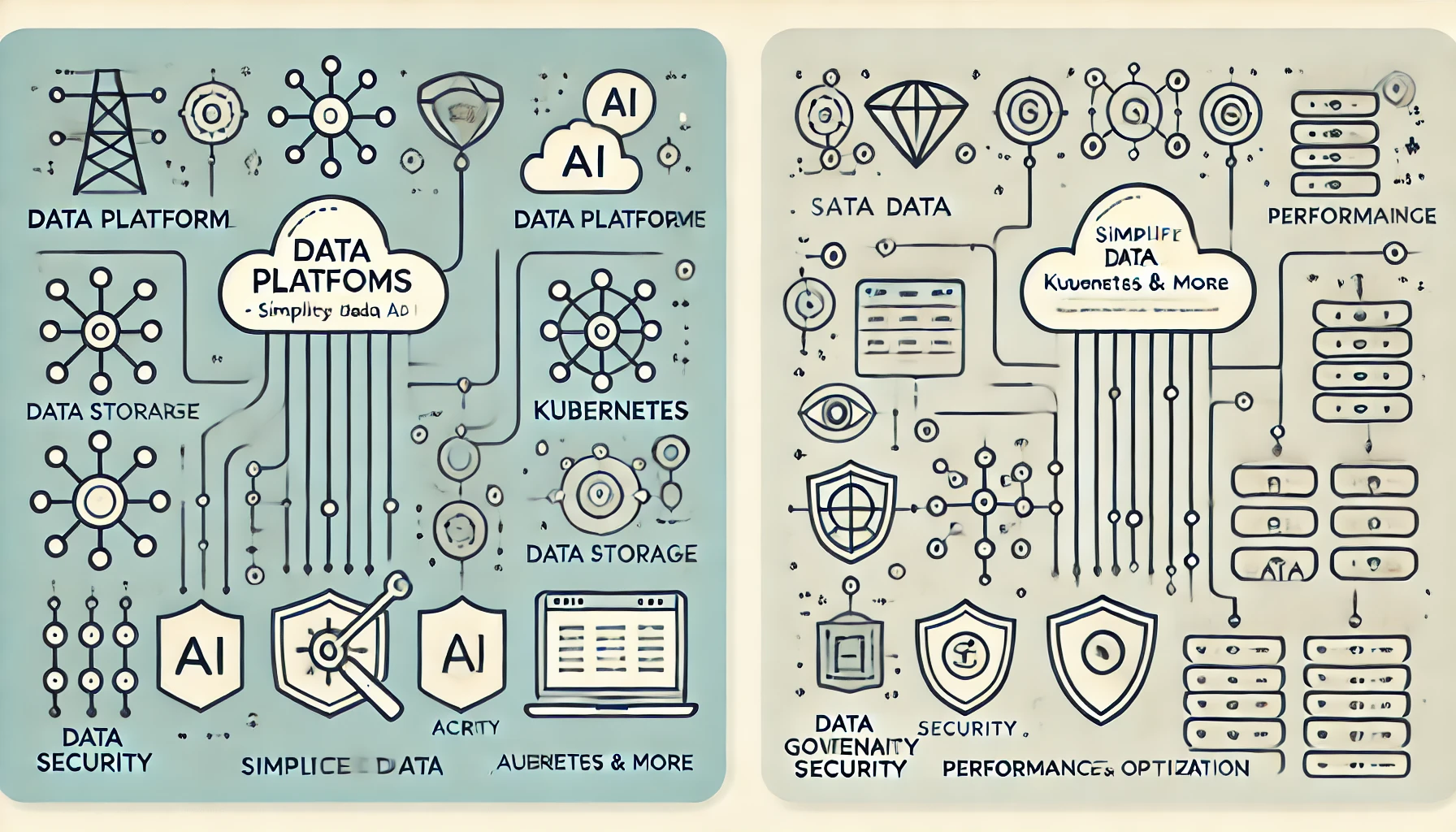
Modern data consumption continues to push the demand for robust data platforms capable of delivering volume, speed, velocity, scale, and security. This chapter provides an exploration of AWS services that facilitate the creation of sophisticated data platforms, with a particular focus on the integration of AI, Kubernetes, data governance, security, and performance optimization. Practical examples using AWS CLI commands and Python code snippets demonstrate the implementation of these technologies.
1. High-Volume Data Handling with Amazon Redshift
Amazon Redshift provides a powerful data warehousing solution, ideal for handling large volumes of data and supporting complex analytical queries that fuel AI-driven analytics.
Example: Creating a Redshift cluster from command line:
aws redshift create-cluster --cluster-identifier my-redshift-cluster \
--node-type dc2.large --master-username myuser --master-user-password mypassword \
--cluster-type single-node --db-name mydatabasePerformance Optimization:
- Use workload management (WLM) to prioritize and allocate memory to critical queries.
- Employ columnar storage and compression techniques to reduce I/O and improve query performance.
- Leverage late materialization features to process only the necessary data.
Data Governance and Quality Management:
- Implement data quality checks within Redshift using SQL constraints and validation queries to ensure data integrity.
- Utilize Redshift Spectrum to manage data lifecycle and archival strategies efficiently.
2. Enhancing Data Velocity with Amazon Kinesis
Amazon Kinesis enables real-time data streaming and processing, allowing businesses to efficiently capture, process, and analyze data streams at scale.
Example: Enhanced Error Handling and Retry Mechanism:
import boto3
import time
from botocore.exceptions import ClientError
kinesis_client = boto3.client('kinesis')
shard_id = 'shardId-000000000000'
try:
shard_iterator = kinesis_client.get_shard_iterator(StreamName='myDataStream', ShardId=shard_id, ShardIteratorType='LATEST')['ShardIterator']
while True:
try:
out = kinesis_client.get_records(ShardIterator=shard_iterator, Limit=2)
shard_iterator = out['NextShardIterator']
records = out['Records']
if records:
print('Received Record:', records)
time.sleep(1)
except ClientError as e:
print(f"Error getting records: {e}")
time.sleep(5) # Wait before retrying
except ClientError as e:
print(f"Error setting up Kinesis consumer: {e}")3. Orchestration with AWS Step Functions
AWS Step Functions is a serverless orchestration service that coordinates multiple AWS services into serverless workflows. It is particularly useful for managing complex data transformations and workflows in data platforms.
Example: Orchestrating a data processing workflow with AWS Step Functions, linking Kinesis, Lambda, and Redshift:
import boto3
import json
sfn_client = boto3.client('stepfunctions')
state_machine_definition = json.dumps({
"Comment": "A simple AWS Step Functions state machine that processes data from Kinesis to Redshift.",
"StartAt": "ReadFromKinesis",
"States": {
"ReadFromKinesis": {
"Type": "Task",
"Resource": "arn:aws:lambda:region:account-id:function:processKinesis",
"Next": "TransformData"
},
"TransformData": {
"Type": "Task",
"Resource": "arn:aws:lambda:region:account-id:function:transformData",
"Next": "LoadToRedshift"
},
"LoadToRedshift": {
"Type": "Task",
"Resource": "arn:aws:lambda:region:account-id:function:loadToRedshift",
"End": True
}
}
})
response = sfn_client.create_state_machine(
name="DataProcessingWorkflow",
definition=state_machine_definition,
roleArn="arn:aws:iam::account-id:role/service-role/StepFunctions-DataProcessing-role"
)
print("State Machine ARN:", response['stateMachineArn'])4. Secure and Scalable Kubernetes Deployments with Amazon EKS
Amazon Elastic Kubernetes Service (EKS) simplifies the deployment, management, and scaling of containerized applications, including those that are data-intensive.
Example: Creating an EKS cluster to host data applications:
aws eks create-cluster --name myDataCluster --role-arn <eks-cluster-role-arn> \
--resources-vpc-config subnetIds=<subnet-ids>,securityGroupIds=<sg-ids>Security Measures:
- Implement role-based access control with AWS IAM Roles for Service Accounts and Kubernetes RBAC.
- Use Amazon Cognito for user authentication in Kubernetes applications.
5. Simplifying Data Integration with AWS Glue
AWS Glue is a serverless data integration service that automates the discovery, preparation, and combination of data for analytics, machine learning, and application development.
Example: Configuring an AWS Glue ETL job:
import boto3
glue_client = boto3.client('glue')
response = glue_client.create_job(
Name='MyETLJob',
Role='GlueServiceRole',
Command={'Name': 'glueetl', 'ScriptLocation': 's3://my-script-bucket/scripts/myetlscript.py'},
DefaultArguments={'--TempDir': 's3://my-temp-bucket'}
)
print("Glue Job Created:", response['Name']). . .
This chapter focuses on data governance, enhanced security, error handling, and optimization strategies to meet the challenges of modern data operations effectively. By utilizing data warehousing, real-time data streaming, workflow orchestration, Kubernetes, and secure data integration, organizations can manage large volumes of data efficiently and effectively.



